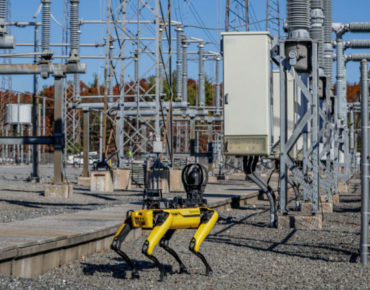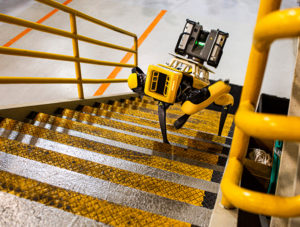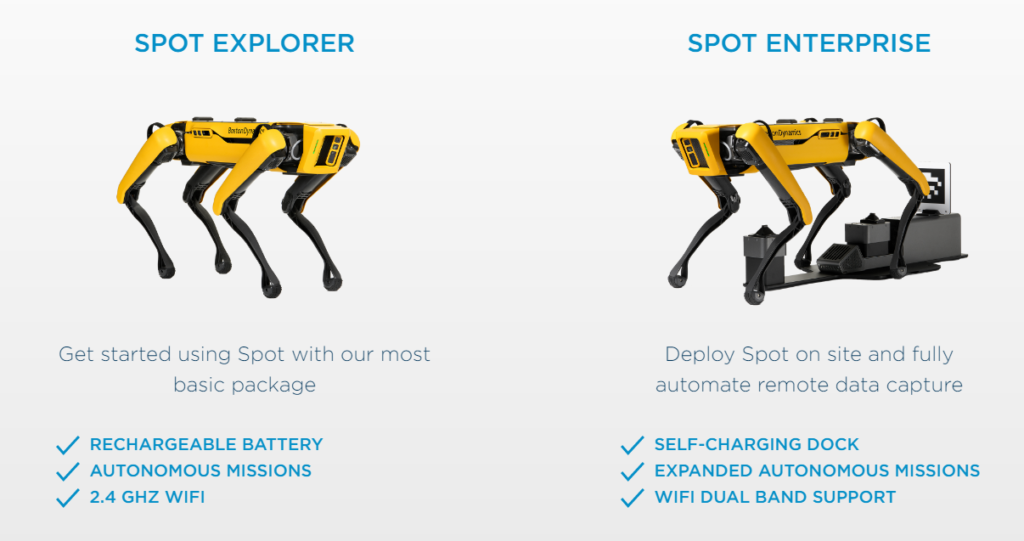| | | IBM, Boston Robotics Using AI and Walking Robots to Rethink and Improve Industrial Monitoring
October 27, 2021 by Todd R. Weiss

As AI-enabled robots in manufacturing facilities, power plants, warehouse and other industrial sites continue to expand in use, more potential use cases are constantly being identified by enterprises that are looking to solve their critical business problems.
In response, IBM and Boston Dynamics are partnering to bring IBM software and Boston Dynamics’ Spot robots together to find answers for customers who are dealing with challenging technology requirements at the edge and in a wide range of industrial settings.
The new collaboration between the two companies, which was announced Oct. 26 (Tuesday), will pair their technologies to focus on conducting data analysis at the edge that will be used to address worker safety, optimize field operations and boost maintenance productivity across many industrial environments.
To fill these needs, IBM Consulting, in conjunction with AI and hybrid cloud innovations from IBM Research, is developing edge software applications to work with a variety of attachable “payloads” that are available for Boston Dynamics’ agile, mobile robot, which is called Spot. The payloads are essentially specialized modules that include a robotic arm, a pan-tilt-zoom camera, a thermal camera for analyzing temperatures during inspections, a LIDAR mapping module and attachable edge CPU or GPU modules.
Through the partnership, IBM and Boston Dynamics are essentially using the Spot walking robot as an intelligent roaming edge device – and equipped with specialized software – that can traverse stairs, rough topography and indoor or outdoor locations, giving operations staff the ability to remotely inspect and monitor equipment with dynamic sensing capabilities.

Skip Snyder of IBM
“If IBM was not part of the picture and you bought a Spot robot, you could use it for remote operations,” Skip Snyder, a senior partner at IBM Consulting who leads the intelligent connected operations practice, told EnterpriseAI. “If you were responsible for a substation, you could wake Spot up at the substation and have it move and see what it sees.”
That could include, for example, an inspection of a bank of valves in a power plant and a subsequent recording of the valve readings, he said. And when those readings are combined with IBM’s edge applications and the specialized payload modules, customers can gain even more insights, he added.
“What we have done is we put on an edge payload that sits on the back of Spots, with performance criteria geared toward AI,” said Snyder. Now, using the analytics aboard Spot, the robot can show what it sees, and customers can run the inferencing at the same time it is reading the valve readings on the bank of valves.
“We can do the inferencing on the edge device to actually say, ‘OK, at the rate that the pressure is increasing, we are going to be out of [the permitted pressure range] in about six hours,” said Snyder. “[A worker then needs to] create a work order and alert somebody and we can actually have Spot create a work order within an enterprise asset management system,” including IBM’s Maximo Application Suite.

One of the first pilot projects using the Spot robot and IBM applications is being conducted by the electric and gas utility, National Grid, which serves Massachusetts and New York. According to the partners, Spot is being used to conduct regularly-scheduled, autonomous inspections at National Grid sites. The integration of IBM advanced AI services gives National Grid new actionable intelligence by processing the data and enabling faster response times when a problem in a facility system is detected.
Currently under field testing is a near real-time inferencing capability that incorporates thermo-visual analysis from inspection data collected by the robot, according to the companies. The new analyses should be able to help identify hotspots and other problems with power station components that could cause serious equipment failures and power outages if left unrepaired. National Grid is planning to use edge data processing via the Spot robot to notify maintenance staff workers as soon as any defects are found so they can make repairs immediately, even as the robot continues its inspection rounds.
The sensing capabilities aboard the Spot robots can scale across multiple facility sites and across many types of equipment using IBM tools and expertise in edge, 5G, security and hybrid cloud, according to IBM and Boston Dynamics.

The first concepts bringing the two technologies together began this past January and were quickly seen as game-changing, said Snyder.
“You stop and think about things from an internet of things (IoT) perspective where you can put sensors on all these assets [used by customers],” he said. “You can put cameras, vibration sensors, microphones on and you can put payloads together to bring all those sensors to multiple assets. The other benefit of it is it is freeing up people to do other higher value work.”
Users can even shift among the sensors in a payload and get information across multiple areas at the same time, giving them more flexibility, said Snyder. “It is being able to go in and look at a piece of equipment in in multiple ways.”
The big differentiator between Spot and other robotic inspection devices is that Spot can go almost anywhere, he said. “I am talking about assets that are spanning large campuses, and it is all outside where the temperatures are above 100 degrees or below zero. But Spot does not care either way and it can walk on whatever terrain happens to be out there.”
Customers can use one Spot robot or multiple Spot robots, depending on their requirements and the sizes of their facilities.
Research and development are continuing with the technology and new features and capabilities will continue to be added over time, said Snyder.

Rob Enderle, analyst
Rob Enderle, principal analyst with Enderle Group, told EnterpriseAIthat the partnership between IBM and Boston Dynamics to make this technology work is understandable.
“We are rolling out the fourth industrial revolution, and no one company can do it all,” said Enderle. “Collaborations like this will be critical to assuring that the coming waves of technology do not also represent a growing danger to the humans that must work in and around these emerging technologies.”
At the same time, the announcement “showcases a critical step to the growing number of autonomous machines that it seems most are missing – the need to update the related hardware,” said Enderle. “These robots, which will eventually be used in massive numbers, need to be maintained and updated to fix bugs, provide more advanced features and distribute training. IBM may be uniquely capable of providing the secure connections needed to capture data at scale to determine if patches and updates are necessary and help deliver those updates securely, so the robots are not compromised.”
That, he said, “could prevent some of the more troubling potential outcomes resulting from large numbers of robotic machines that are not patched rapidly enough to avoid catastrophic problems or are compromised by hackers wishing to do harm.”

enterpriseai.news |
|










